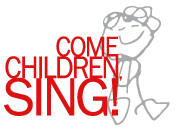These songs are a part of childhood! The rich heritage of children’s songs you may have grown up with can provide delightful activities with your child. They charm, entertain, invite participation, and carry the culture. They are not, however, the richest material for music learning. Words, rather than music, are the driving force in traditional children’s songs, with music the attractive “wrapping paper” for the words.
The many wonderful children’s folk songs serve the same purpose for music development as the many delightful nursery rhymes do for language development. Nursery rhymes enrich the process of learning language, while providing much joy and shared activity, but they do not, in themselves, teach the language. Children have to learn to interact through language in the context of meaningful communication. A child’s recitation of a nursery rhyme demonstrates a different skill than using language to communicate appropriately in context. Similarly, a child’s delivery of a traditional children’s song demonstrates a different skill than being able to sing tunefully and move rhythmically in the “context” of tonality and meter.
Traditional children’s folk songs are generally limited tonally and rhythmically, just as they are in words. The more we have uncovered about the young child’s music development, the more we know that your child is ready for far more sophisticated material musically.
So, enjoy all the songs and chants from your own childhood with your child, just as you do nursery rhymes, knowing those delightful songs and rhymes serve only part of the process of learning music or language.
|

